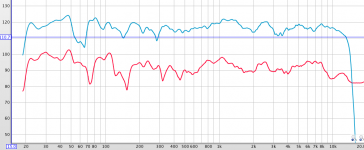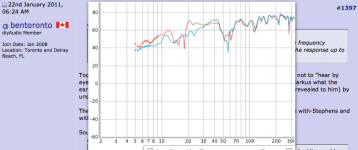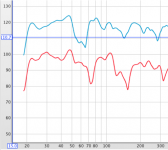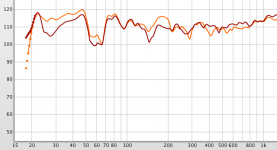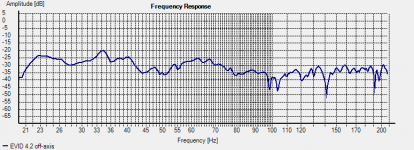Ben,Depending on all kinds of factors, you might benefit from alignment or you migh not be remotely able to achieve any kind of alignment or you might not need alignment or some combination of those depending on the room, damping, symmetry, speaker location, and direct or dipole, and who knows what more.
Based on reading posts, it looks to me like alignment can help at times and alignment can't help at times.
Time alignment of different low frequency sound sources with differing radiation patterns at different distances from "you" (a specific location) can always be done, and will benefit that specific location, but will make other locations worse.
Ben,
Time alignment of different low frequency sound sources with differing radiation patterns at different distances from "you" (a specific location) can always be done, and will benefit that specific location, but will make other locations worse.
Without disputing a single word of your thoughts, it can still be asked what constitutes "specific location"? Or how much benefit? Or how much worse are these other locations and do these "other locations" include raising my chin to have a sip of tea?
Ben
Ummm, can't wait to get a miniDSP and align my 12 foot folded corner horn (south east corner) with my meter-square dipole ESLs standing out in the room and my giant mid-wall OB with a highly irregular baffle board a couple of feet away; good thing the tweeter is exactly aligned dimensionally
Ben,Without disputing a single word of your thoughts, it can still be asked what constitutes "specific location"? Or how much benefit? Or how much worse are these other locations and do these "other locations" include raising my chin to have a sip of tea?
Ummm, can't wait to get a miniDSP and align my 12 foot folded corner horn (south east corner) with my meter-square dipole ESLs standing out in the room and my giant mid-wall OB ..
The frequency responses you posted in #1394 and 1397 show huge variations (20+dB) in LF response, given your choice of speakers and locations, hard to say how much improvement you will see/hear with time alignment at the listening position.
If you are crossing your subs around 100 Hz, any usual head movement probably won't have much effect on what you hear in the crossover region, but a few feet in any direction could have large (+/- 12 dB) variations. Of course, that is already occurring now, without DSP, with DSP at least you could get fairly flat (+/- 6 dB) response in one location, which does not appear to be the case presently.
After you get your MiniDSP and do some testing and listening you will be able to answer the questions for yourself.
Good luck, have fun!
You would have to prove this to me because it violates the time/frequency equivalence concept. Why DBA would do it but multiple subs would not is clearly not obvious and not even possible IMO. DBA is a multiple sub implementation, just a very specific one.People think they are getting one (smooth frequency response) with the other (low ringing). This is not the case with multiple subs. The only exception is a DBA.
Multiple subs is better than one sub no matter what room you have. They just work even better if the room is well damped. The two things (multiple subs and damping) are uncoupled and do not have to be discussed together - so I usually don't.
I cannot visualize what is to be gained by "time aligning" the individual sources. Can you "time align" the room modes??? I think not
At which frequencies?? Given the variations in room geometries, and the wavelengths involved, at best you'd be (technically) correcting one small subset of frequencies at one point in space, probably to the detriment of others, by using an over-analytical measured approach. (other than perceived and/or measured reduction in room mode variation)
Too many degrees of freedom to do this other than empirically, as I see it
At which frequencies?? Given the variations in room geometries, and the wavelengths involved, at best you'd be (technically) correcting one small subset of frequencies at one point in space, probably to the detriment of others, by using an over-analytical measured approach. (other than perceived and/or measured reduction in room mode variation)
Too many degrees of freedom to do this other than empirically, as I see it
Yes, without step 1 it would be impossible to time align anything.
Well, then here's where we differ. There is no "right" time. When do the frequencies of a subwoofer arrive at the listening position? An analogy: "a 100 car freight crosses the road in front of you. What time did the train cross the road?". Taken from Phase Alignment of Subs – Why I don’t use the impulse response ? Bob McCarthy
You would have to prove this to me because it violates the time/frequency equivalence concept. Why DBA would do it but multiple subs would not is clearly not obvious and not even possible IMO. DBA is a multiple sub implementation, just a very specific one.
I'm interested in practical results. Every multiple sub installation I've seen so far is worse than DBA or a near field sub. You refuse to post any measurements of your room, so we don't know if everybody else is just doing something wrong somehow. DBA is probably the optimal multisub configuration and all other attempts are inferior.
Multiple subs is better than one sub no matter what room you have. They just work even better if the room is well damped. The two things (multiple subs and damping) are uncoupled and do not have to be discussed together - so I usually don't.
Well, a DBA works best if there's no passive damping at all because the rear array is the damping. So if passive damping has to be added despite multiple subs are used then they are simply not effective in terms of damping. In theory the result should also not be a flat frequency response because as you've said "it violates the time/frequency equivalence concept". So why is there still damping needed although the frequency response can be made reasonably flat with multiple subs?
And by the way, I would never recommend a single sub over multiple subs.
Last edited:
Markus,Well, then here's where we differ. There is no "right" time.
I completely agree with what Bob McCarthy wrote:
"How do we couple two time-stretched systems together? In this case it is pretty simple. We will couple the subwoofer train right behind the mains. The rear of the mains is 100 Hz and the front of the subs is the same. We will run the systems in series. The critical element is to link them at 100 Hz. (I am using 100 Hz as an example – this can, and will vary depending upon your particular system).
The procedure is simple. measure them both individually, view the phase and adjust the delay until they match. You have to figure out who is first and then delay the leader to meet the late speaker. This will depend upon your speaker and mic placement. I say this is simple - but in reality , it is quite difficult to see the phase response down here. Reflections corrupt the data – it is a real challenge. Nonetheless, it can be done. It’s just a pain."
What Bob wrote is what I have been proposing, phase/time alignment in the crossover region between subs and mains.
Art
^
Now add multiple subs. Aligning each and every sub as described by McCarthy does NOT automatically result in the smoothest response within acoustically small rooms (I guess he's talking about PA under free field conditions) - not in the crossover region nor below.
Now add multiple subs. Aligning each and every sub as described by McCarthy does NOT automatically result in the smoothest response within acoustically small rooms (I guess he's talking about PA under free field conditions) - not in the crossover region nor below.
Markus,
I completely agree with what Bob McCarthy wrote:
"How do we couple two time-stretched systems together? In this case it is pretty simple. We will couple the subwoofer train right behind the mains. The rear of the mains is 100 Hz and the front of the subs is the same. We will run the systems in series. The critical element is to link them at 100 Hz. (I am using 100 Hz as an example – this can, and will vary depending upon your particular system).
The procedure is simple. measure them both individually, view the phase and adjust the delay until they match. You have to figure out who is first and then delay the leader to meet the late speaker. This will depend upon your speaker and mic placement. I say this is simple - but in reality , it is quite difficult to see the phase response down here. Reflections corrupt the data – it is a real challenge. Nonetheless, it can be done. It’s just a pain."
What Bob wrote is what I have been proposing, phase/time alignment in the crossover region between subs and mains.
Art
Seems like this would be impossible to do in a small room where steady state is the only option, hence lots and lots of reflections. The phase in the upper part of the modal region would be darn near random. This technique is obvious for large venues when the crossover is above the modal region, but it appears to me to be inapplicable in the modal region.
OK, alignment can help from zero up to some quite valuable degree depending on room damping, multiple subs (the topic of this thread), etc. etc. Fun, interesting, potentially helpful, and for some posting here, profitable. Who could argue about that?
Now I'd like to ask an important question that hasn't been asked.
Besides the obvious dollar and fuss burden, what are the "costs" and down-sides of introducing technology for the various kinds of alignment?
For sure, a small amount of S/N is lost and some THD, of course. We almost certainly need to dive into the digital world (although my electronic crossover has a 68 cm adjustment!!).
Are we getting into unwelcome complexities that make other tuning harder?
Anything made worse acoustically when you align the sub(s) with the middles at the crossover?
Ben
Now I'd like to ask an important question that hasn't been asked.
Besides the obvious dollar and fuss burden, what are the "costs" and down-sides of introducing technology for the various kinds of alignment?
For sure, a small amount of S/N is lost and some THD, of course. We almost certainly need to dive into the digital world (although my electronic crossover has a 68 cm adjustment!!).
Are we getting into unwelcome complexities that make other tuning harder?
Anything made worse acoustically when you align the sub(s) with the middles at the crossover?
Ben
Last edited:
Ben,Besides the obvious dollar and fuss burden, what are the "costs" and down-sides of introducing technology for the various kinds of alignment?
For sure, a small amount of S/N is lost and some THD, of course. We almost certainly need to dive into the digital world (although my electronic crossover has a 68 cm adjustment!!).
Are we getting into unwelcome complexities that make other tuning harder?
Anything made worse acoustically when you align the sub(s) with the middles at the crossover?
Delay of adequate length to time align a system such as yours at the crossover point would be best served by DSP, which may (or may not) have more THD and less S/N than an analog crossover, as your path length differences are many meters (due to the long horn path in addition to the much closer mains position), not centimeters.
Getting the sub/main alignment within 1/4 wavelength smooths response, at 100 Hz that allows around +/- 2.8 feet difference in placement.
I can't think of any downside of time alignment at the crossover point.
In every case of time alignment in the crossover region I have seen measurable improvement in response.
I agree with Markus and Earl that aligning each and every sub as described by McCarthy does not automatically result in the smoothest response within acoustically small rooms, but using it as a starting point when the time differences in arrival time are large compared to room size and crossover wavelength as in your case would be worth a try, seems hard to think that it could result in a response worse than your measurements showed.
Whether the modal response of your room would swamp any benefits of time aligning your disparate arrival times really can only be determined by trying and measurement.
Ignoring those old traces for a moment, here're some rather nicer new ones made with REW a few minutes ago.Ben,
The frequency responses you posted in #1394 and 1397 show huge variations (20+dB) in LF response, given your choice of speakers and locations, hard to say how much improvement you will see/hear with time alignment at the listening position.
If you are crossing your subs around 100 Hz, any usual head movement probably won't have much effect on what you hear in the crossover region, but a few feet in any direction could have large (+/- 12 dB) variations. Of course, that is already occurring now, without DSP, with DSP at least you could get fairly flat (+/- 6 dB) response in one location, which does not appear to be the case presently.
After you get your MiniDSP and do some testing and listening you will be able to answer the questions for yourself.
Good luck, have fun!
The upper trace is where my nose usually is when listening to music. I have some pride in these results for a smallish room, pretty much within 5 dB, 19 Hz to 15 Hz, give or take a bit, above the bass. (It would be interesting to see weltersys's traces?)
The lower one, shifted for clarity, is made by moving my listening easy-chair 24 inches back. Treble sadder. The bass fluctuations are still roughly where they were but changed in level.
Awaiting the comments of others, my first impression is that it is my room (15.0 x 9.48 x 8.05 feet) that is a dominant influence, with alignment not mattering so much. Or has the mis-alignment carried over?
Ben
Attachments
Last edited:
Ben,Ignoring those old traces for a moment, here're some rather nicer new ones made with REW a few minutes ago.
It would be interesting to see weltersys's traces?
Awaiting the comments of others, my first impression is that it is my room (15.0 x 9.48 x 8.05 feet) that is a dominant influence, with alignment not mattering so much. Or has the mis-alignment carried over?
The response of my living room stereo from the listening position is shown in post # 1661.
The single sub adds a "loudness contour" increasing response from 80 to 30 Hz, worst case dip is around -8 at 190 Hz. The "loudness contour" can be flattened by simply by lowering sub level, but at the low levels I listen at I generally prefer a bit more "weight".
Markus sub response posted in #1625 shows a reduction in frequency response deviation in the crossover transition region from around 17 dB to 8 dB using delay on (some of) his subs.
Your response posted in #1713 has more bass (or less top) than the one you posted in 1397, but still shows around a 20-22 dB variation in the crossover region, the curves prior curves look similar as far as the depth and frequency of the dips as the ones recently taken.
Again, whether room, time alignment, speaker radiation patterns or a combination thereof are causing the frequency response problems could only be determined by testing with properly aligning the subs and mains and comparing the results- Markus set up shows a definite improvement, whether yours would is to be determined.
Art
Attachments
I'll avoid invidious comparisons of whose curves are prettier and stick to the topic. Except to mention that Art has no need to apologize for bass boosting because all people with experience (or who read DIYaudio) know that flat bass sounds lousy.
We often have an issue at this forum (or any place data is displayed) of cherry-picking data to support a certain viewpoint. So I wonder if you can twiddle with the "alignment knob" to eventually produce an optimum curve?
And without pointing to any particular traces, "optimum" means better at some points and decidedly worse at others (often a hard decision which is greater).
Below is more data from my music room - requiring some explanation. My ESLs are part-way into the room (duh) and the Klipsch horn is in a corner behind one of them (duh, again).
So the horn is maybe, sort of, like 8-15 feet (you tell me) behind the right ESL panel. And it is some quite different distance by a profoundly indescribable but quite different distance from the L panel.
That should mean, the L+sub and R+sub output should be WAY OFF in alignment and weird bumps and dips in their respective sound curve. That is, if alignment trumps room. Below are the curves. (Even if the speakers were next to one another, there'd be major bumps and dips... so some divergences are expected. Divergence under 40 Hz relates to my mid-wall giant OB... don't ask.)
Ben
We often have an issue at this forum (or any place data is displayed) of cherry-picking data to support a certain viewpoint. So I wonder if you can twiddle with the "alignment knob" to eventually produce an optimum curve?
And without pointing to any particular traces, "optimum" means better at some points and decidedly worse at others (often a hard decision which is greater).
Below is more data from my music room - requiring some explanation. My ESLs are part-way into the room (duh) and the Klipsch horn is in a corner behind one of them (duh, again).
So the horn is maybe, sort of, like 8-15 feet (you tell me) behind the right ESL panel. And it is some quite different distance by a profoundly indescribable but quite different distance from the L panel.
That should mean, the L+sub and R+sub output should be WAY OFF in alignment and weird bumps and dips in their respective sound curve. That is, if alignment trumps room. Below are the curves. (Even if the speakers were next to one another, there'd be major bumps and dips... so some divergences are expected. Divergence under 40 Hz relates to my mid-wall giant OB... don't ask.)
Ben
Attachments
Last edited:
Ignoring those old traces for a moment, here're some rather nicer new ones made with REW a few minutes ago.
The upper trace is where my nose usually is when listening to music. I have some pride in these results for a smallish room, pretty much within 5 dB, 19 Hz to 15 Hz, give or take a bit, above the bass. (It would be interesting to see weltersys's traces?)
The lower one, shifted for clarity, is made by moving my listening easy-chair 24 inches back. Treble sadder. The bass fluctuations are still roughly where they were but changed in level.
Awaiting the comments of others, my first impression is that it is my room (15.0 x 9.48 x 8.05 feet) that is a dominant influence, with alignment not mattering so much. Or has the mis-alignment carried over?
Ben
For what it's worth, aren't Ben's upper trace, in which he has "some pride," showing nearly 20 dB variance between, say, 30 Hz and 300 Hz (mostly under 100 Hz), while Markus's traces, which Ben calls "horrible," showing about 15 dB variance between the same frequency range (mostly between 200-300 Hz)? Also, no information on Ben's smoothing was presented?
Last edited:
For what it's worth, aren't Ben's upper trace, in which he has "some pride," showing nearly 20 dB variance between, say, 30 Hz and 300 Hz (mostly under 100 Hz), while Markus's traces, which Ben calls "horrible," showing about 15 dB variance between the same frequency range (mostly between 200-300 Hz)? Also, no information on Ben's smoothing was presented?
Yes, I used the word "horrible" and immediately after apologized for being rhetorically carried away making a point. Did you notice that post? See many apologies on anonymous forums?
Yes, my curves are at least as "horrible." At those levels of smoothing, all smallish room curves are horrible. Are we into nasty invidious comparison posts now instead of discussing alignment, ridiculing people for having "some pride"?
1/12 octave. I believe using anything finer muddies the important facts with unimportant fussy details that can't be addressed.
And your curves, youngho?
Ben
Last edited:
And your room, youngho?
Don't know about his room, but here's mine, taken a few minutes ago:
I suspect it would be even smoother in the 50 Hz region and the phase at the x-over frequency needs to be adjusted a little , but SWMBO's in there folding clothes and has two of the windows near to the listening position open and she's not conducive to sine sweeps at the moment, so...
The subwoofers? One 10" driver in a 2.5 cu.ft. vented alignment (Fb=21 Hz) , in the front right corner of the living room.
Attachments
Yes, I used the word "horrible" and immediately after apologized for being rhetorically carried away making a point. Did you notice that post? See many apologies on anonymous forums?
Oh, I'm sorry, I noticed "Right. I got caught up in making my point that the difference [between "the first curves are horrible. So are the second"] is smallish" and "Tell me, markus76, would you have preferred if I said, "the first is a trivial badness, and the second is a trivial less badness." I'm sorry I missed the apology.
Yes, my curves are at least as "horrible." At those levels of smoothing, all room curves are horrible. Are we into nasty invidious comparison posts now instead of discussing alignment? Ridiculing people for having "some pride"?
I actually think that Markus's curves below the transition zone frequencies are actually quite remarkable, not horrible at all! I suspect that the variance in the 200-300 Hz region are likely to be related to be related to SBIR, rather too high to be well addressed by multiple subwoofers, anyway.
I decline to reply to the terms "nasty," "invidious," or "ridicule." Please restrict yourself to technical arguments.
1/12 octave. I believe using anything finer muddies the important facts with unimportant fussy details that can't be addressed.
Thank you. As I recall, Floyd Toole expressed slightly different feelings about frequencies below the transition zone, but I could certainly be mistaken. Anyway, helpful to know.
And your room, youngho?
Soon, I hope. I'm still adjusting main loudspeaker position in my room, then it will be integration of the JBL BassQ unit I had picked up a few years ago for the subwoofers.
Last edited:
Don't know about his room, but here's mine, taken a few minutes ago
snip
Brian -
Good stuff. Always brave to post your stuff.... which is why we read more talk (and snide criticism) and see less posted data.
Do you have the means of varying the alignment of your bass or mid drivers to illuminate the thread?
I've experimented with my my tweeter angle and position over recent years.
Neato to aim my curved four-cell ESL tweeter array so as to put the mic more in a beam (or for cone users, a lobe). I have a range of no more than maybe 4 dB of beam influence at 10kHz* (while keeping the array still facing mostly forward!). By aiming (without touching the amp), I can adjust my traces to be more flatter at more frequencies. But I can't honestly report that makes the sound of music in the room (or listening with two ears) any different. Without diss'ing freq curves, they alone don't tell the whole story.
Likewise, moving my tweeters a couple of inches forward or back will shift around the bumps and valleys vis a vis the middle ESL panels. That kind of alignment nicely improves my cross-over region curve without too much impacting other regions. But with the Haas Effect and all, can anybody hear the difference the mic hears on-axis? I like to have the best alignment for the tweeters even if it is hard to define "alignment" when my tweeter array is on a cylinder and the mid array is on a sphere!!!
But about bass... at this moment, I'm still with the alignment-skeptics, thinking the room is the far larger impact, at least for my complicated two-sub system, as per the topic of this thread.
Ben
*critics of ESLs assume beaming is a major liability of the technology but 4 dB at 10kHz is pretty mild considering
Last edited:
- Home
- Loudspeakers
- Subwoofers
- Multiple Small Subs - Geddes Approach
